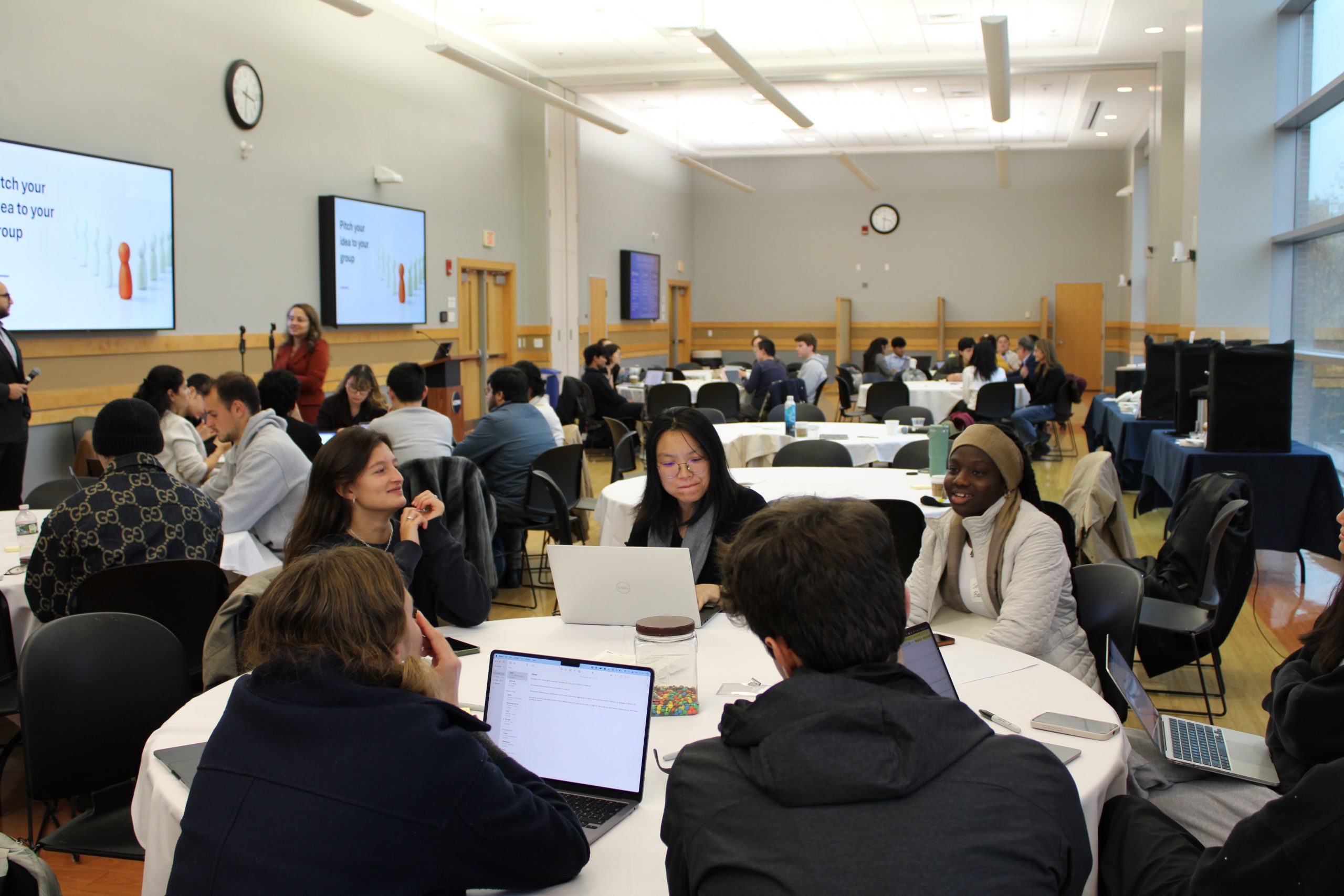
As Fred Carofano’s advanced placement students file into his East Hartford statistics class, he hands out a playing card that determines where they will sit and gives them a quick statistics problem to work on. If they get it right, they get a stamp that yields points at the end of the semester and augments their grade. But the real purpose of the exercise is to get them quickly into the mindset for the lesson that day.
“I would highly recommend that you all write this down, because you know that if I really like this question there’s a high probability it will show up again,” he says.
He speaks in a playful patter, but he’s in teacher mode. He hands out packets of dice that will be used to analyze whether players can win money in a game of chance. “If you open these dice as I put them on the table, your group will have a zero for the day,” he warns.
“Hey, Brianna, can you open these dice for me,” he coaxes.
“Don’t do it,” some classmates yell.
“Just a test,” Carofano says.
Rapping for Math
It’s no surprise that Carofano (Neag IB/M ’06-’07) attracts math-avoiding AP students to his statistics classes at East Hartford High School. No surprise that in his first year of teaching statistics, about half of his class did well enough on the year-end test to qualify. And no surprise that the National Math and Science Initiative (NMSI) named him 2009-2010 All American Teacher of the Year in the state’s math category.
“He definitely makes a personal connection with students so they’re not afraid of the content,” says Allison Anderson, assistant principal at East Hartford High School and former head of the school’s math department. “They end up taking challenging courses with Fred because he kind of puts them at ease, but he doesn’t reduce the rigor in any way.”
Carofano does find meeting ground in the math thicket. To motivate his students one year, he offered to grow out his thick, curly hair and let them shave it off in the spring if they did well on the AP test. When some female students felt left out of the action, he agreed to let them straighten his hair before the big shave-off, and he was a good enough sport to keep it that way for a few periods.
But his most renowned move to date was to write a stats rap with his musician roommate at the time, and a remix the next year. That won him an interview on WTIC radio in Hartford. The rap is posted on MySpace and on the NMSI site, as is his classroom stats blog. He plans to top it somehow this school year.
So throw your hands up and do the AP Stat
The one and only class where we bringin mean back
We rockin p hats
And kickin math raps
Tell me bout a class that’s better than that
So from the front to the back and
The x and y axis
Throw your r’s high like you’re scatterplot graphin
Megan Staples, assistant professor of mathematics education at Neag who taught and advised Carofano, calls his work at East Hartford exceptional. “I recall being at Bulkeley, talking with a seasoned veteran there, who also serves as a cooperating teacher for us, and she mentioned how she was teaching statistics. This was fairly new territory for her. She said she’d been learning a lot (and stealing a lot of materials!) from a teacher at East Hartford. Turns out that was Fred.”
Carofano piloted the AP statistics classes at East Hartford High as part of Project Opening Doors, which aims to get more minority and low-income students into AP courses. As the project’s lead AP teacher, he hosts Saturday review sessions for students in nine participating districts. He worked with statistics textbook author David Bock of Cornell University to try lesson ideas in the classroom. And he teaches an Early College Experience elementary math modeling course through UConn.
Career Trajectory
Carofano is low key about his accomplishments, and quick to credit past teachers: Jackie Tetreault (Neag BA ’73) at Lyman High School in Wallingford; Staples and Mary Truxaw, math educators in the Neag School of Education; and associate professor Keith Conrad in the UConn math department in the College of Liberal Arts and Sciences.
“[Keith Conrad] was the best math teacher I ever had,” Carofano says. “He made some crazy math accessible. He’s on a whole ’nother level than me. He went on this little rant about how prime numbers were used to encrypt credit cards. One time he went into a bunch of math to explain the Rubik’s Cube to us.”
Tetreault, his high school teacher, remembers his excellence in calculus and his humor. “He is the type of student that every teacher dreams of,” she says.
Carofano got the teaching bug in high school, and in college decided to choose math over English as his focus because for him math has more “unexplored territory.” A probability question will pop into his head when he’s playing a board game or waiting at a traffic light. He tries to shape problems for his students that will appeal to their tastes. As for his own, among his many tattoos he wears one that depicts an addition symbol from the Renaissance.
Carofano gets the routine requests that come to all mathematicians – that they figure the restaurant bill, or help a friend with a college math class. A guidance official dropped by after class to ask his advice on whether to present professional data via a pie chart or bar chart. But sometimes he’s asked to use his skill in shadier ways.
“Everyone wants to know if you can count cards,” he says. “It’s just one up and one down, like it was on the movie [’21’], but you have to do it wicked fast.”
In his short time in the field, Carofano already has a success story or two. One he mentions is former student Andrew Jackwin, now a statistics major at American University in Washington, D.C. who gives full credit to Carofano: “What I have learned since then is only a product of Mr. Carofano’s teaching. I can say with confidence that I wouldn’t be here right now if it wasn’t for him.”
Jackwin comes back to the school to visit Carofano’s classes. “He teaches me statistics now,” says his former teacher.
Carofano recently moved back to his hometown of Wallingford. His mom and dad are the service manager and parts manager, respectively, at a Toyota dealership. Neither of them was able to go to college. “So they were pretty happy when I decided to go. … They took care of me.”
He hopes to teach at the college level in the future, and perhaps change subjects, but says what he’d really love to do is come back to UConn and get an advanced degree – “something in math.”


